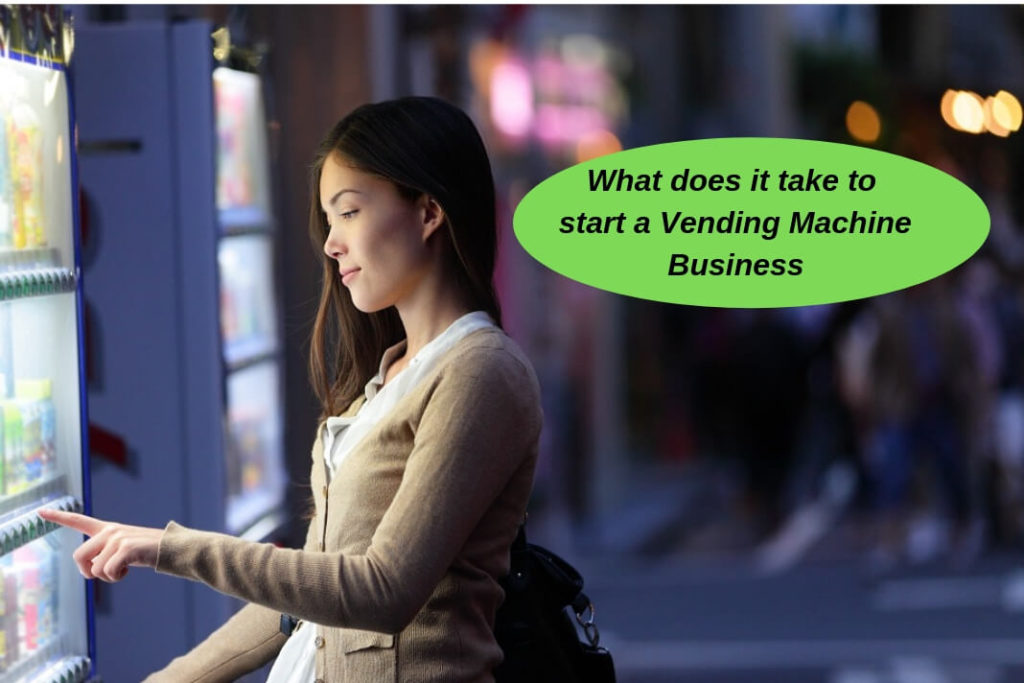
Vending machines are trending. You find them everywhere, in coffee shops, metro stations, at the cinemas, parks and so many other places where there is a crowd. They are easy-peasy and time efficient. Many individuals have started their own vending machine business in the last year and have successfully got away from their monotonous 9 – 6 job.
In this article, we have outlined the steps to start a vending machine business with less capital.
Reasons are Aplenty
You could start vending machine business yourself. The reasons to start are many: you work the way you want to achieve your goals and no one would question you, the work you pour into your business will pay you back in the form of dividends and profits, and you grow your assets. Do you gain the required freedom to spend your time doing what interests you the most, probably skiing?
Since vending machines are mostly a passive business, you will not have to be present in your office during working hours. In fact, you can be absent most of the time and your work won’t be affected. Vending machines are quite scalable businesses, so, making it large is never going to be a question.
Finally, you could be a smart vending business owner who provides healthy alternatives to junks for people in need, in places where the products are unavailable. You could be the reason for people to make healthier life choices.
Now that you know why this is a great business idea, let us move on to the steps of starting this business.
What a Successful Vending Machine Business Looks Like
A Successful vending machine business provides value to people. It is built upon this unwavering thought. It is not only about selling the product in places where the products are not accessible. There are approximate 4 million vending machines in the US alone. Most vending machines operate by stocking their food with traditional junks. That is why new entrants are trying to add healthier options. If you live in any other country, this is the right time to explore this business.
A typical vending machine business day looks something like this: hit your computer to check which locations’ machines need to be restocked, fill products in your transport vehicle, reach the locations, restock the products in machine, refill the coin box with money such as dimes, quarters, dollar coins etc., and then move on to the next location.
This is going to be your everyday errand and at the end of the day, you will have to sit in front of your computer to check the inventory to reorder products, do the accounts and manage the supply chain.
You don’t need to have any extraordinary management skills to be successful in this business. All you need is willpower, a ‘WOW’ factor, full stock, and continuity. Let’s not forget health and hygiene quotient.
If you ask us, the only hard part of starting a vending machine from scratch is finding the locations for your machines and products. And, the next biggest challenge is going to be driving around the locations, emptying the cans, refilling them, and cleaning them. You need to occasionally fix the machines as well.
So, we suggest you take baby steps. As in, choose a location and work in and around it. Don’t go beyond a few kilometers in radius in the beginning.
Do Some Market Research
Look for potential spots and get the feel of foot traffic. Take a survey to find out what kind of vending machines the pedestrians want and what the missing options in the society are. So, three things you need to look out for include: number of possible locations, traffic in those locations, and potential products for those locations. For instance, you cannot sell greasy burgers in upscale locations.
Once you have identified these three things, try talking to hosts to let you put a vending machine at their place. You could probably tell them about the benefits of vending machines and how the owners can gain credibility from the business.
Choose Your Type of Vending Machine
The most common vending machines are beverages, followed by junks, gourmets, candies, and confections. However, we recommend that you focus on a new niche. Your vending machine type will depend upon the capital fund, product type and cost, product shelf life, profit margin, and location.
You can opt for low costs and low margin business, such as selling familiar products with maximum shelf life. Selling these products can be started with low upfront costs in terms of machinery and equipment. They are easy to stock and easy to order. However, since they are packaged foods, they tend to have the lowest margins. Toys, candies, canned and bottled beverages, packed items, such as cookies, biscuits, chips, crackers etc. and non-food items, such as gift coupons, phone cards, supplies etc. fall under this category.
Alternatively, you can up your competitive spirit and raise your capabilities by selling higher cost and higher margin products. You will have to invest more in good and sophisticated machines for such products. The products that fall in this range include frozen foods or hot foods, hot beverages, such as coffee, milk and tea, electronics, fitness foods, ice-creams etc.
The operating cost is high, the machines are expensive, and the cleaning and maintenance cost is also high. However, these products gain maximum attention and provide higher margins.
Trending Vending Machine Business Ideas
If you want to look beyond the traditional vending machine business options, here are few trending segments you should consider:
- Fitness and Health Products: Flavoured water, juicers, sports drink, protein and granola bars, nuts, fruits, fruit salads, etc. The target market includes schools, gymnasiums, corporate offices etc.
- Honora Markets: Here more than the machines and products, the focal point is the target micro market. They are an extension of healthier options and focus on organic and fresher foods, including freshly made, perishable, and warm foods.
Micro markets are mostly kiosks operated, where customers pay either by cash or by swiping card. No staffs are involved. Micro markets are new entrants and are now powered by selective dominant players. They have high ongoing management costs and higher upfront machinery cost.
Now that you know your options, as a start-up with a low capital fund, we recommend that you start with a low-cost, low-margin, healthier snack centered, niche market targeted business.
Start Picking Your Products
Once you have assumed your vending machine business structure, you need to start picking out your products to sell. If you are targeting a particular niche, say schools and colleges, stock your products appropriate for that niche or location. Product mix, demand, pricing will impact your profits. The higher the price of products the better the margin, considering an average of 10 vends per day. You need to mark up your products 100% or more and price it to the nearest quarter.
Based on this, you have to calculate your profits. A typical vending machine has 30 to 40 items for display. You need not go that high. Pick your items based on locations, your pricing experiment, and your competition.
One of the ways to get better at pricing is by acquiring the products from large snack wholesalers or directly from the manufacturers. However, in their cases, you have to maintain a consistent order size, probably very large. Choose this option once you start managing a certain size.
Purchase Your Machines
A new vending machine usually costs around $3,000 to $5,000. The price varies based on the type of snack you offer and the functionalities of the machine, such as card swipe or cash. Some of the checkpoints that you need to tick while looking for a machine include:
- Size, features, and configurations
- Refrigeration or not
- Payment options – card, cash
- Design – Punching or digital window
- Electronically programmable prices
Most vending machines of today do not have a card reader. However, this is a world of digitization, and you could bring that to your advantage. People are carrying less and less cash nowadays, so a card reader enabled vending machine will receive more attention and applauds than traditional ones.
However, the upfront cost will be $500 more for the reader. Additional charges that you may incur include bank transaction fee of 3% to 5% and a monthly charge. Such machines also require a cellular connection. Now that’s easy to get hold of, thanks to the advancement of technology.
There is one more option that you may probably want to look at. A certain type of vending machine allows customers to pay for the food using your smartphone, such as Apple payment apps, Google Pay, PayTM etc. If you are planning to place your vending machines in upscale, affluent locations, this is a great choice.
Acquire Your Locations
Your location should have foot traffic. That should be your first characteristics of the location. Your location should also be away from other options, such as parks, café etc., should have long wait time with no food options nearby, and should be accessible late in the night when other restaurants are closed.
Some of the popular choices for vending machine locations include:
- Factories
- Mid and small sized hotels
- Schools and colleges
- Gymnasiums
- Hospitals
- Health care facilities, such as 24*7 pharmacies
- Community centers
- Transport Hubs
- Metro stations
- Motels
- Repair shops
- Laundromats
- Health clubs
- Sports club
- Pet shops and hospitals
- Airports and public transport depots
- Car washes
To stay clear from your competitors, you need to be on your toes always, funneling enough products for each location. To win and max out revenues, manage a great product mix and pricing. And, the best way to do so is creating and maintaining a lasting relationship with the owners of the location and the users who use the machines.
Build relationships by communicating directly with your end users, ask their suggestions and feedbacks and work on them proactively.
Three Most Important Elements of a Successful Vending Machine Business
Now that everything is set and you are out on the road, running, you should start driving sales and converting rate into profit. So, three elements that will definitely determine the success of a vending machine business include:
1. Well Stocked Vending Machines
Keep your machines as full as possible. The more empty your vending machines are, the older the remaining products look to users. This is proven human psychology. In the beginning, plan frequent trips to check on your machines until you purchase a remote monitoring system. A few trips to the locations will give you an idea for how quickly your stocks get over.
2. Hygiene of the Machines
If your machines are dirty, users will assume your food stale and poor quality. It will decrease sales and brand value. On the other hand, if you clean your machines regularly, the products inside will not only look fresh but also cost of machinery maintenance will come down. Cleansed machines will also attract fewer bugs and rots, saving your products from getting affected with pests.
3. Health of the Machines
Service your machinery as per schedule. Rectify tiny faults immediately before it blows up to a malfunction. Regardless of how clean you keep your machines, it will eventually tie-up and breakdown. So, you need to fix it from time to time. A vending machine at an average requires one to two services per year, depending upon the age of the machine, who services it, and where it is located.
It is recommended to invest in great quality, brand new vending machines when you are starting the business. Else, you will end up making frequent visits to the service center, which will sooner or later add up to the sum cost of new machinery.
If you get through these steps, rest assure you are on your way to building a commendable vending machine business. Don’t forget to consult an attorney before you register for your business and before you generate finance for the start-up. Let us know your queries in the comments below. We shall answer your doubts at the earliest.




